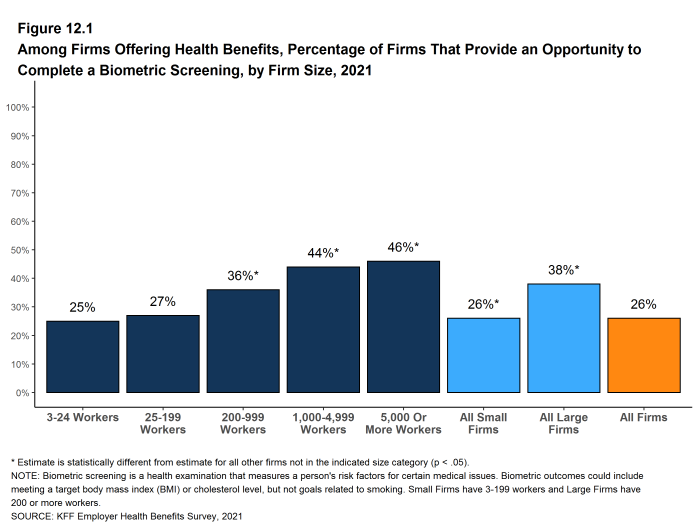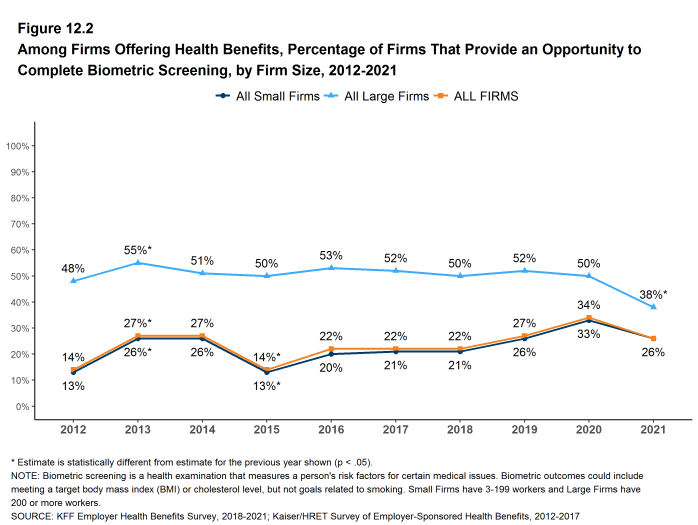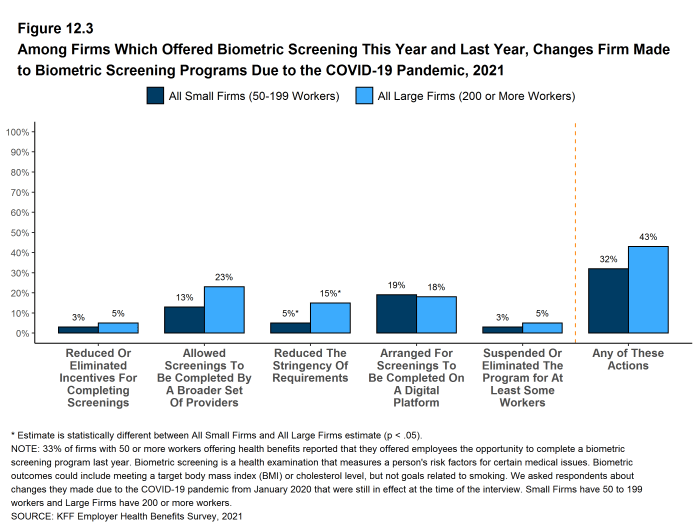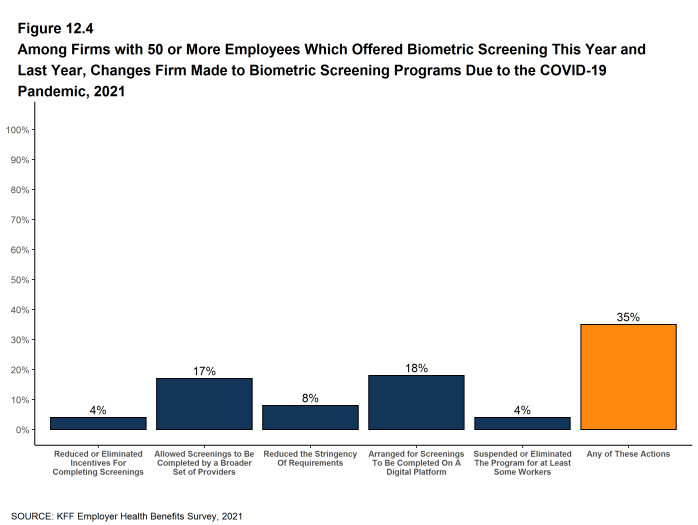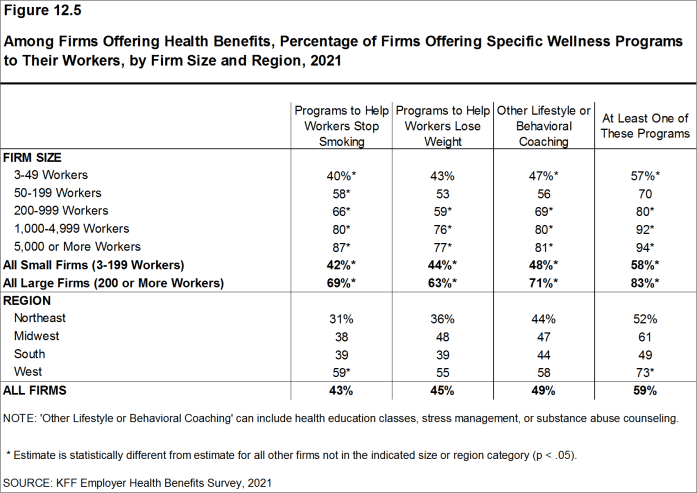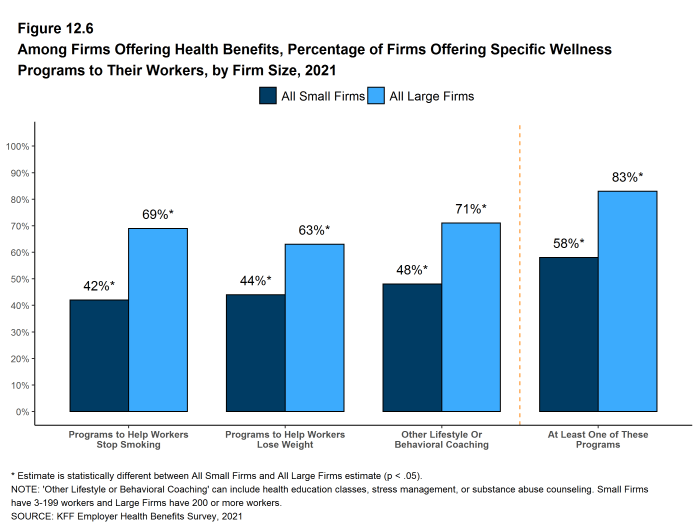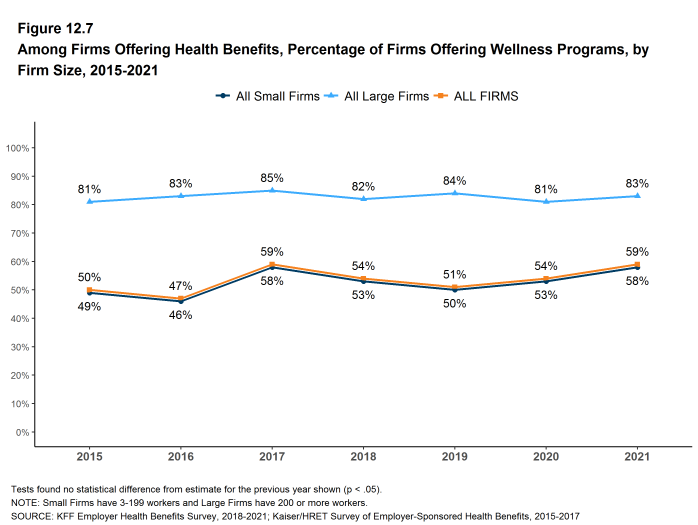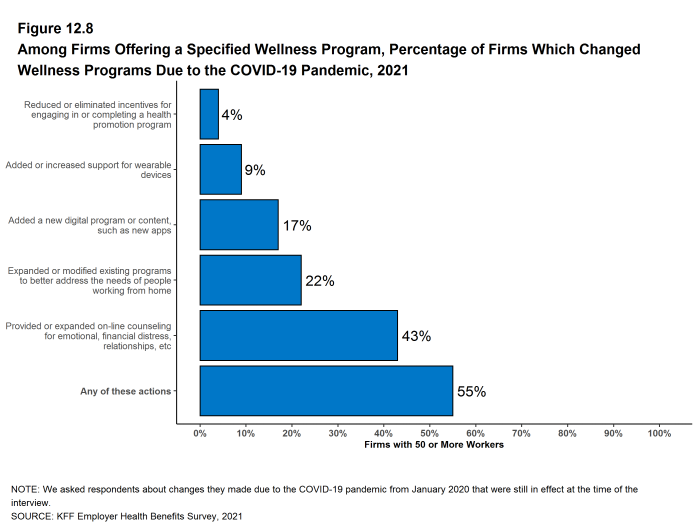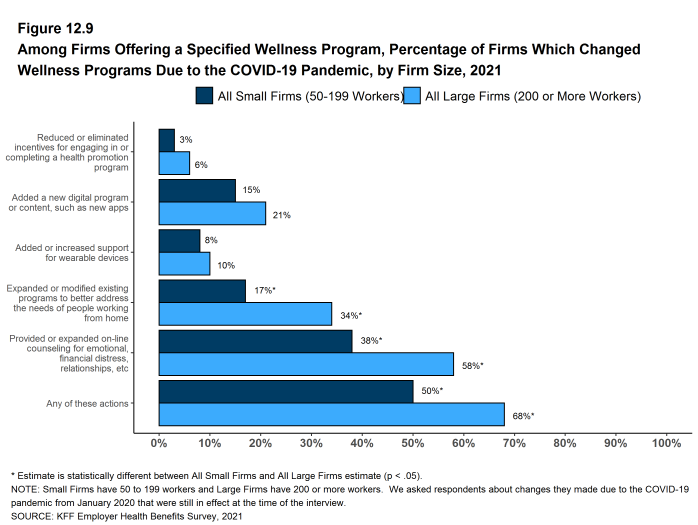2021 Employer Health Benefits Survey
Section 12: Health Screening and Health Promotion and Wellness Programs
Most firms offer some form of wellness program to help workers and family members identify health issues and manage chronic conditions. Many employers believe that improving the health of their workers and their families can improve morale and productivity, as well as reduce health care costs. Only firms offering health benefits were asked about their wellness and health promotion programs.
In addition to offering wellness programs, a majority of large firms now offer health screening programs, including health risk assessments, which are questionnaires asking workers about lifestyle, stress, or physical health, and biometric screening, which we define as in-person health examinations conducted by a medical professional. Firms and insurers may use the health information collected during screenings to target wellness offerings or other health services to workers with certain conditions and to understand employee health risks. Some firms have incentive programs that reward or penalize workers for different activities, including participating in wellness programs or completing health screenings.
The COVID-19 pandemic placed stress on employer health promotion and wellness activities. Many employees worked remotely for large stretches of 2020, and many avoided public places, including medical offices and gyms. For these employees, achieving wellness goals or targets was a struggle, and some employers responded by modifying their health screening, health promotion and wellness programs in recognition of these challenges. This calendar year began with large shares of workers still working remotely and many people continuing to avoid unnecessary public contacts. Due to these uncertain circumstances, we modified our questions for 2021 about health screening and wellness to focus on changes that employers and payers made to accommodate the challenges workers had and may still have in achieving and maintaining good health.
Among firms with 50 or more employees offering a biometric screening opportunity both this year and last year, 32% of small firms (50-199 employees) and 43% of larger firms report making some change in their biometric screening programs since the start of the COVID-19 pandemic.
Among firms with 50 or more employees offering a health promotion or wellness program this year, 50% of smaller firms (50-199 employees) and 68% of larger firms reported making some change to their health promotion programs since the start of the COVID-19 pandemic.
BIOMETRIC SCREENING
Biometric screening is a health examination that measures a person’s risk factors (such as cholesterol, blood pressure, and body mass index (BMI)) for certain medical issues. A biometric outcome involves assessing whether the person meets specified health targets related to certain risk factors, such as meeting a target BMI or cholesterol level. As defined by this survey, goals related to smoking are not included in the biometric screening questions.
- Among firms offering health benefits, 26% of small firms and 38% of large firms provide workers the opportunity to complete a biometric screening [Figure 12.1]. The percentage of large firms providing workers the opportunity to complete a biometric screening is lower than the percentage last year (50%) [Figure 12.2]. In fact, 45% of large firms offering health benefits in 2021, including 16% of large firms not offering a biometric screening opportunity this year, report offering a biometric screening opportunity in 2020.
- Firms with at least 50 employees offering a biometric screening opportunity both this year and last year were asked about changes that they have made to their programs since the start of the COVID-19 pandemic. Overall, among firms offering a biometric screening opportunity both this year and last year, 32% of small firms (50-199 employees) and 43% of larger firms report making some change in their biometric screening programs since the start of the COVID-19 pandemic [Figure 12.3].
- Three percent of smaller firms and 5% of larger firms reduced or eliminated incentives for completing the screening.
- Thirteen percent of smaller firms and 23% of larger firms permitted screenings to be completed by a broader set of providers.
- Five percent of smaller firms and 15% of larger firms reduced the stringency of screening requirements.
- Nineteen percent of smaller firms and 18% of larger firms arranged for biometric screenings to be performed on a digital platform.
- Three percent of smaller firms and 5% of larger firms suspended or eliminated the program for some workers.
Figure 12.1: Among Firms Offering Health Benefits, Percentage of Firms That Provide an Opportunity to Complete a Biometric Screening, by Firm Size, 2021
Figure 12.2: Among Firms Offering Health Benefits, Percentage of Firms That Provide an Opportunity to Complete Biometric Screening, by Firm Size, 2012-2021
Figure 12.3: Among Firms Which Offered Biometric Screening This Year and Last Year, Changes Firm Made to Biometric Screening Programs Due to the COVID-19 Pandemic, 2021
WELLNESS AND HEALTH PROMOTION PROGRAMS
Large shares of employers continue to offer educational and other programs to help workers engage in healthy lifestyles and reduce health risks. Wellness and health promotion programs may include exercise programs, health education classes, health coaching, and stress-management counseling. These programs may be offered directly by the firm, an insurer, or a third-party contractor. As with biometric and other screening programs, employers made changes for 2020 and 2021 in reaction to the COVID-19 pandemic.
- Among firms offering health benefits, 42% of small firms and 69% of large firms offer programs to help workers stop smoking or using tobacco, 44% of small firms and 63% of large firms offer programs to help workers lose weight, and 48% of small firms and 71% of large firms offer some other lifestyle or behavioral coaching program. Overall, 58% of small firms and 83% of large firms offering health benefits offer at least one of these three programs [Figure 12.6] and [Figure 12.7]. These percentages are similar to the percentages last year.
Figure 12.5: Among Firms Offering Health Benefits, Percentage of Firms Offering Specific Wellness Programs to Their Workers, by Firm Size and Region, 2021
Figure 12.6: Among Firms Offering Health Benefits, Percentage of Firms Offering Specific Wellness Programs to Their Workers, by Firm Size, 2021
CHANGES TO WELLNESS AND HEALTH PROMOTION PROGRAMS
- Firms with 50 or more employees with a wellness or health promotion program were asked if they made changes to their programs since the beginning of the COVID-19 pandemic. Overall, 50% of smaller firms (50-199 employees) and 68% of larger firms reported some type of change.
- Three percent of smaller firms and 6% of larger firms reduced or eliminated incentives associated with their program [Figure 12.9].
- Fifteen percent of smaller firms and 21% of larger firms added a new digital program or digital content to their program.
- Eight percent of smaller firms and 10% of larger firms increased support for wearable devices.
- Seventeen percent of smaller firms and 34% of larger firms expanded or modified the content of their existing programs to better address the health needs of people working from home.
- Thirty-eight percent of smaller firms and 58% of larger firms provided or expanded on-line counseling services for emotional or financial distress, relationship issues, or other stressful situations.
Figure 12.8: Among Firms Offering a Specified Wellness Program, Percentage of Firms Which Changed Wellness Programs Due to the COVID-19 Pandemic, 2021

